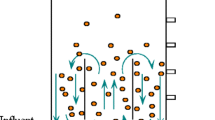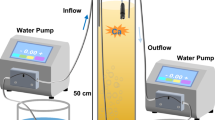Abstract
Two sequential aerobic sludge blanket reactors were concurrently operated to examine the effect of Ca2+ augmentation on aerobic granulation. Augmentation with 100 mg Ca2+ l−1 significantly decreased the time to cultivate aerobically grown microbial granules from 32 d to 16 d. Ca2+-fed granules were denser and more compact, showed better settling and strength characteristics, and had higher polysaccharide contents.
Similar content being viewed by others
References
APHA (1998) Standard Methods for the Examination of Water and Wastewater, 20th edn. Washington, D.C.: American Public Health Association.
Beun JJ, Hendriks A, van Loosdrecht MCM, Morgenroth E, Wilderer PA, Heijnen JJ (1999) Aerobic granulation in a sequencing batch reactor. Water Res. 33: 2283–2290.
Bruus JH, Nielsen PH, Keiding K (1992) On the stability of activated sludge flocs with implications to dewatering. Water Res. 26: 1597–1604.
Christensen BE (1989) The role of extracellular polysaccharides in biofilm. J. Biotechnol. 10: 181–202.
Costerton JW, Cheng KJ, Geesey GG, Ladd TI, Nickel JC, Dasgupta M, Marrie TJ (1987) Bacterial biofilm in nature and disease. Annu. Rev. Microbiol. 41: 435–464.
Dubois M, Gilles KA, Hamilton JK, Rebers PA, Smith F (1956) Colorimetrix method for determination of sugars and related substances. Anal. Chem. 28: 350–356.
Fletcher M, Floodgate GD (1973) An electron-microscopic demonstration of an acid polysaccharide involved in the adhesion of a marine bacterium on solid surface. J. Gen. Microbiol. 74: 325–334.
Frolund B, Palmgren R, Keiding K, Nielsen PH (1996) Extraction of extracellular polymers from activated sludge using a cation exchange resin. Water Res. 30: 1749–1758.
Grotenhuis JTC, van Lier JB, Plugge CM, Stams AJM, Zehnder AJB (1991) Effect of ethylene glycol-bis (β-aminoethyl ether)-N, N-tetraacetic acid (EGTA) on stability and activity of methanogenic granular sludge. Appl. Microbiol. Biotechnol. 36: 109–114.
Huang J, Pinder KL (1995) Effects of Ca2+ on development of anaerobic acidogenic biofilms. Biotechnol. Bioeng. 45: 212–218. Lettinga G (1995) Anaerobic digestion and wastewater treatment systems. Anton. Leeuw. Int. J. G. 67: 3–28.
Mahoney EM, Varangu LK, Cairns WL, Kosaric N, Murray RGE (1987) Effect of Ca2+ on microbial aggregation during UASB reactor start-up. Water Sci. Technol. 19: 249–260.
Morgan JW, Forster CF, Evison LW (1990) Comparative study of the nature of biopolymers extracted from anaerobic and activated sludges. Water Res. 24: 743–750.
Morgenroth E, Sherden T, van Loosdrecht MCM, Heijnen JJ, Wilderer PA (1997) Aerobic granular sludge in a sequencing batch reactor. Water Res. 31: 3191–3194.
Moy BYP, Tay JH, Toh SK, Liu Y, Tay STL (2002) High organic loading influences the physical characteristics of aerobic sludge granules. Lett. Appl. Microbiol. 34: 407–412.
Ohashi A, Harada H (1994) Adhesion strength of biofilm developed in an attached growth reactor. Water Sci. Technol. 29: 281–288.
Schmidt JE, Ahring BK (1996) Granular sludge formation in upflow anaerobic sludge blanket (UASB) reactors. Biotechnol. Bioeng. 49: 229–246.
Seviour RJ, Blackall LL (1999) The Microbiology of Activated Sludge. Dordrecht: Kluwer Academic Publishers.
Shen CF, Kosaric N, Blaszczyk R (1993) The effect of selected heavy metals (Ni, Co and Fe) on anaerobic granules and their extracellular polymeric substance (EPS). Water Res. 27: 25–33.
Sutherland IW (2001) Biofilm exopolysaccharides: a strong and sticky framework. Microbiology 147: 3–9.
Tay JH, Liu QS, Liu Y (2001) The effects of shear force on the formation, structure and metabolism of aerobic granules. Appl. Microbiol. Biotechnol. 57: 227–233.
Teo KC, Xu HL, Tay JH (2000) Molecular mechanism of granulation: proton translocation activity. J. Environ. Eng. 126: 411–418.
van Loosdrecht MCM, Lyklema J, Norde W, Schraa G, Zehnder AJB (1987) Electrophoretic mobility and hydrophobicity as a measure to predict the initial steps of bacterial adhesion. Appl. Environ. Microbiol. 53: 1898–1901.
Veiga MC, Jain MK, Wu WM, Hollingsworth RI, Zeikus JG (1997) Composition and role of extracellular polymers in methanogenic granules. Appl. Environ. Microbiol. 63: 403–407.
Yan YG, Tay JH (1997) Characterization of the granulation process during UASB start-up. Water Res. 31: 1573–1580.
Yu HQ, Tay JH, Fang HHP (2001) The roles of Ca2+ in sludge granulation during UASB reactor start-up. Water Res. 35: 1052–1060.
Zhang TC, Bishop PL (1994) Density, porosity, and pore structure of biofilms. Water Res. 28: 2267–2277.
Author information
Authors and Affiliations
Corresponding author
Rights and permissions
About this article
Cite this article
Jiang, HL., Tay, JH., Liu, Y. et al. Ca2+ augmentation for enhancement of aerobically grown microbial granules in sludge blanket reactors. Biotechnology Letters 25, 95–99 (2003). https://doi.org/10.1023/A:1021967914544
Issue Date:
DOI: https://doi.org/10.1023/A:1021967914544




